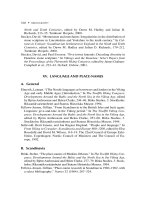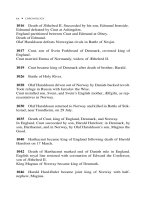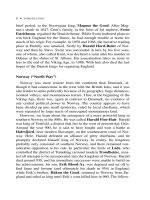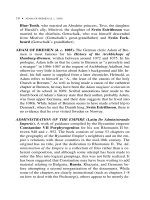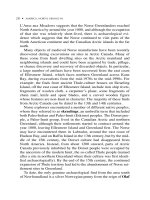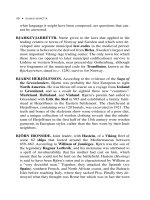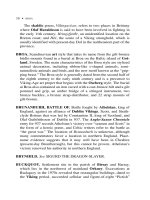The A to Z of the Vikings 9 potx
Bạn đang xem bản rút gọn của tài liệu. Xem và tải ngay bản đầy đủ của tài liệu tại đây (65.32 KB, 10 trang )
The skaldic poem, Víkingavísur, refers to two places in Brittany
where Olaf Haraldsson is said to have been involved in fighting in
the early 11th century: Hringsfjör
ð
r, an unidentified location on the
Breton coast; and Hól, the scene of a Viking stronghold, which is
usually identified with present-day Dol in the northeastern part of the
province.
BROA. Scandinavian art style that takes its name from the gilt-bronze
bridle-mounts found in a burial at Broa on the Baltic island of Got-
land, Sweden. The main characteristics of the Broa style are stylized
animal decoration, including ribbon-like s-shaped animals, semi-
naturalistic animals and birds, and the new motif known as the “grip-
ping beast.” The Broa style is generally dated from the second half of
the eighth century to the early ninth century and is a precursor to
Viking-Age art proper that begins with the Oseberg style. The burial
at Broa also contained an iron sword with a cast-bronze hilt and a gilt
pommel and grip, an amber bridge of a stringed instrument, two
bronze buckles, a bronze strap-distributor, and 22 strap mounts of
gilt-bronze.
BRUNANBURH, BATTLE OF. Battle fought by Athelstan, king of
England, against an alliance of Dublin Vikings, Scots, and Strath-
clyde Britons that was led by Constantine II, king of Scotland, and
Olaf Guthfrithsson of Dublin in 937. The Anglo-Saxon Chronicle
entry for 937 records Athelstan’s victory over “seamen and Scots” in
the form of a heroic poem, and Celtic writers refer to the battle as
“the great war.” The location of Brunanburh is unknown, although
many commentators favor a location in northern England. Place-
name evidence suggests that it may well have been in Cheshire
(present-day Bromborough), but this cannot be proven. Athelstan’s
victory renewed his authority in northern England.
BRYNHILD. See SIGURD THE DRAGON-SLAYER.
BUCKQUOY. Settlement site in the parish of Birsay and Harray,
which lies in the northwest of mainland Orkney. Excavations at
Buckquoy in the 1970s revealed that rectangular buildings, dated to
the Viking period, succeeded cellular and figure-of-eight “Pictish”
58 • BROA
(see Picts) buildings. However, the break in house types is not re-
flected in the artifactual assemblage, which continued to be domi-
nated by native Pictish-style products. The excavator argued on the
basis of this evidence that there was some degree of social interaction
between the native population and the incoming Norse settlers in the
early Viking Age. Although this conclusion was called into question
with the suggestion that the Pictish artifacts were found in Viking-
Age deposits because of the site’s disturbed stratigraphy, the absence
of distinctive Norse-style artifacts from the rectangular structures
supports the continued use of Pictish-style artifacts in the new
houses.
The possibility that the rectangular buildings at Buckquoy were
occupied by Picts rather than Vikings has been raised by the discov-
ery of rectilinear buildings dated to the Pictish period at Skaill in
Deerness on Orkney, although these were not known when Buckquoy
was published in 1974. Nevertheless, other sites in the Bay of Birsay
area share this lack of diagnostic Norse artifacts and the survival of
earlier, native types in the early Viking Age. However, the survival
of such artifacts does not necessarily presuppose a nonviolent con-
frontation. Even if the Pictish population had been wiped out, it
seems unlikely that useful objects would be thrown away.
BURIALS. In the period before the Viking Age, cremation burial was
the norm throughout Scandinavia. However, both cremation and in-
humation burial were practiced in Viking-Age Scandinavia, and the
latter became more and more common toward the end of the period
following the conversion to Christianity. During the Viking Age,
cremation nevertheless predominated throughout Norway and most
of Sweden, while inhumation was already more common in Denmark
(including the southern tip of Sweden, that was part of the medieval
kingdom of Denmark) and the island of Gotland at the beginning of
the period. The reason for this contrast is unknown, although it has
been suggested that the early changeover to inhumation in Denmark
might reflect closer links with Christian Europe.
In the countryside it appears that individuals were normally
buried on the family farm, but in urban areas, burials were concen-
trated in cemeteries on the outskirts of towns. Extensive cemeteries,
which have been partially excavated, surround the towns of Birka in
BURIALS •59
Sweden and Hedeby in Denmark. Before the conversion to Chris-
tianity, the deceased was usually dressed and accompanied by per-
sonal possessions, known as grave goods, with both forms of burial.
These grave goods might vary from the everyday clothes and objects
used by the individual to more lavish items, presumably intended for
display. With cremation burials, these were all burned on a funeral
pyre with the deceased, and the remains were then gathered and
buried in a number of ways: the cremated bones may have been
placed in a pot and buried in the ground; they may have been scat-
tered in the grave itself; or all the remains from the pyre may have
been put in a so-called cremation pit. Many cremation graves con-
tain the burned bones of domestic animals, such as horses, dogs,
pigs, cattle, sheep, and fowl. It was normal for cremation graves to
be marked by a low burial mound or by stones, often arranged in the
shape of a ship (known as a ship-setting). A large number of these
stone-settings surround the cremations in the cemetery at Lindholm
Høje in Denmark. Ibn Fadlan provides a famous account of a cre-
mation burial involving a ship that took place on the River Volga in
Russia during the early 10th century.
Burial in a ship (or a wagon or cart) and the use of ship-settings
may suggest the belief that transportation was necessary to reach
the next world, or possibly it was another way of emphasizing the
high social status of the individual being buried. Similarly very
large burial mounds, such as those found at Jelling in Denmark and
Borre in Norway, have been interpreted as marking the burials of
particularly wealthy and important individuals. One of the most fa-
mous examples of an inhumation burial in a ship is that from Ose-
berg in southwest Norway. Other forms of inhumation practiced
during the Viking Age include elaborate chamber-graves, where the
grave was lined with a wooden “house” with corner posts, floor,
roof, and wall-paneling; simple coffin graves, where a simple cof-
fin was placed in a grave; and, most basic of all, graves where the
corpse was placed straight into the ground. Although some rune-
stones are found in close proximity to stone-settings and burial
mounds, rune-stones were not grave-stones, and they often appear
to have been placed in prominent sites that would attract the atten-
tion of passers-by, such as roadsides, rather than in cemeteries or on
graves.
60 • BURIALS
Conversion to Christianity changed burial practices in Scandi-
navia: not only did inhumation become more common, the orienta-
tion of graves shifted from north-south to east-west, and the new
religion discouraged the inclusion of grave goods in burials. Instead,
the dead were usually placed in a shroud rather than their clothes and
were buried in a simple wooden coffin that was placed in enclosed
consecrated land, usually surrounding a church. Nevertheless, social
distinctions remained in the Christian era: the upper classes were
buried nearer the church than the lower classes, and priests and the
very wealthy and important were buried inside the church, under
the floor. Graves were probably marked above ground, with wooden
markers or grave-stones, which provided a further opportunity to dis-
play social status.
BURRAY. One of the largest known Viking silver hoards in the British
Isles was discovered at Burray on Orkney, Scotland. It consists of
about a dozen coins, 26 pieces of ring money or plain silver arm
rings, two small neck rings, and 111 pieces of hacksilver fragments,
weighing some 2 kilograms in total. This hoard had been partly buried
in a wooden container and then placed in a peat bog, and its burial is
dated to between c. 997–1010.
BYZANTIUM (ON Mikligar
ðð
r “great town”). City on the site of
present-day Istanbul (Turkey) founded by the Roman emperor, Con-
stantine, in AD 330. Byzantium was the capital of the eastern half of
the Roman Empire and was still the center of a large eastern empire
in the Viking Age. It was visited by Scandinavian raiders and traders
who exchanged northern furs and slaves for luxury goods such as
wines, spices, jewelry, and silks. Three trade treaties between the Rus
of Russia and Byzantium, dating from 907, 912, and 945, are
recorded in the Russian Primary Chronicle. This also records
Viking attacks on the city: by Askold and Dir in 863–866 and by
Oleg in 904–907. The Homilies of Photius, written by the patriarch of
the city, also refer to the attacks by Askold and Dir. From the end
of the 10th century, the emperor of Byzantium had a famous Scandi-
navian bodyguard, known as the Varangian Guard, which attracted
mercenaries and warriors from all over northern Europe. Scandina-
vian runes have been found in Byzantium’s Hagia Sofia church.
BYZANTIUM •61
– C –
CAMP DE PÉRAN. Circular fortress on the northern coast of Brittany
in present-day France. Excavations suggest that the Vikings and the
Bretons (or French) fought a battle here in the early 10th century, al-
though it is not clear if the Vikings were defending or attacking the
fortress. The earth ramparts of the fort were burned and finds include
a Viking sword; two spearheads; an ax; a silver penny, c. 905–925,
from Anglo-Scandinavian York; a wool comb; and an iron pot. It has
been suggested that the destruction of the fortress might be linked
with the end of Viking rule in Brittany c. 936.
CANUTE. See CNUT I THE GREAT.
CAROLINGIAN EMPIRE. The Carolingian dynasty replaced that of
the Merovingians and was established in 751, when Peppin II became
king of the Franks. The Carolingian Empire was the creation of
Charlemagne and included much of the former territory of the west-
ern part of the Roman Empire. It reached its greatest extent during the
rule of Charlemagne’s son, Louis the Pious, when the empire
stretched from the Pyrenees and Italy in the south to the Low Coun-
tries (see Frisia) in the north. However, following Louis’s death, the
empire was divided among his three sons: Lothar received the Mid-
dle Kingdom of Lotharingia and Italy; Louis the German, the East
Frankish kingdom, approximating to modern Germany and Austria,
and Charles the Bald, the West Frankish kingdom, which later be-
came France. This division, formalized in the Treaty of Verdun (843),
initiated a period of civil war, which weakened effective resistance to
Viking incursions.
The earliest Viking raids on the Carolingian Empire affected
Frisia, including the important trading centers at Dorestad and
Quentovic, at the very end of the eighth century. Charlemagne con-
structed coastal defenses that were temporarily effective at keeping
the Vikings at bay. Some time around 838 the focus of Viking activ-
ity shifted west, and the Viking armies established raiding bases
shortly afterward on islands in the rivers Seine and Loire. As well as
enabling the Vikings to raid all year round, sailing up these rivers
opened up the interior of the Carolingian Empire. Paris was attacked
62 • CAMP DE PÉRAN
on at least three occasions, most famously in 885 (see Paris, Siege
of), after which Charles the Fat was deposed for his failure to deal
with these Vikings effectively. Grants of land were made to Scandi-
navians in the hope that they would limit further Viking incursions,
the most famous of which was made by Charles the Simple in 911
to one Rollo, thus establishing the Duchy of Normandy. See also
ANNALS OF FULDA; ANNALS OF ST-BERTIN; BRITTANY,
VIKINGS IN; CHARLES THE BALD; NOIRMOUTIER, ERMEN-
TARIUS OF; ROYAL FRANKISH ANNALS.
CHARLEMAGNE (742–814). King of the Franks 768–814 and em-
peror of the Frankish or Carolingian Empire 800–814. Much of
Charlemagne’s reign was spent in territorial conquest, which brought
his empire to the southern border of Denmark at the very beginning
of the Viking Age. Charlemagne waged war in the name of Chris-
tianity, suppressing paganism in Saxony and encouraging church re-
form and learning from his court at Aachen in present-day Holland.
Charlemagne’s response to early Viking raids was to order the forti-
fication of bridges across major rivers so as to prevent Viking fleets
from sailing upriver, and a system of coastguards at the mouths of
rivers was established. These measures prevented serious Viking ac-
tivity in Frankia until the 830s.
CHARLES II THE BALD (823–877). King of the West Franks
840–877 and emperor 875–877, Charles was grandson of Charle-
magne and the youngest son of Louis the Pious. Charles’s resistance
to Viking raids was weakened by the threat of his rebellious brothers.
From 845, Viking armies were frequently paid off, and, in 858, his
siege of the Viking stronghold on the island of Oissel in the Seine was
cut short by the rebellion of his brother, Louis the German. However,
Charles did enjoy some success against Scandinavian armies, and in
873 he won a major victory over the Loire Vikings at Angers.
CHARLES III THE FAT (839–891). King of Alemannia 870, king
and emperor in Italy 880, king of the East Franks 882, and king of the
West Franks 884, Charles was the great-grandson of Charlemagne
and the youngest son of Louis the German. Charles’s most famous
encounter with Scandinavian armies was his relief of their yearlong
CHARLES III THE FAT (839–891) •63
siege of Paris in 886, after which he paid them tribute and allowed
them to ravage Burgundy. Shortly afterward, in 887, he was deposed
and replaced by Count Odo, the defender of Paris, and his own
nephew Arnulf.
CHARLES IV THE SIMPLE (879–929). King of the West Franks
898–922, Charles was the grandson of Charles II the Bald. His most
famous dealing with Scandinavian armies was the granting of land in
Neustria (later known as Normandy) to a group of Vikings led by
Rollo. According to Dudo of St-Quentin, this grant was confirmed
in writing by a treaty signed at St. Clair-sur-Epte in 911. Charles
was deposed and imprisoned in 922 and was murdered in 929.
CHRISTIANITY, CONVERSION TO. The first recorded Christian
mission to Scandinavia took place before the beginning of the Viking
Age, when St. Willibrord visited the kingdom of Angantyr of Den-
mark c. 700. According to the Vita Willibrordi, written by the Anglo-
Saxon cleric Alcuin, the pagan Angantyr sold Willibrord some 30
boys to be trained as priests. Little else is known about Willibrord’s
mission.
In the early ninth century, another mission to Scandinavia was
launched under the leadership of Ansgar, so-called Apostle of the
North. The immediate impetus to this mission was political condi-
tions in Denmark, where there was conflict between two rivals for the
kingdom. One of the contenders for the Danish throne, Harald Klak,
sought the assistance of the Frankish emperor, Louis the Pious, and
he was baptized, along with his family and his retainers, at Ingelheim
in 826. Following this episode, the emperor arranged for two church-
men, Ansgar and Autbert, to accompany Harald back to Denmark and
provide spiritual guidance for him and his newly converted follow-
ers. Two principle sources record the events surrounding Harald’s
conversion: Rimbert’s Life of St. Ansgar (Vita Anskarri) and Er-
moldus Nigellus’s Carmen in honorem Hludowici, but while Rim-
bert’s account places the conversion in Frankia after the exile and
highlights the importance of Louis and Ansgar in Harald’s conver-
sion, Ermoldus writes that Harald had already been virtually won
over to the faith following the missionary work of Archbishop Ebo of
Reims in Denmark in 823. Nevertheless, it is clear that following
64 • CHARLES IV THE SIMPLE (879–929)
Harald’s baptism, Ansgar embarked upon the conversion of both
Denmark and Sweden, visiting these kingdoms in the late 820s and
again in the 850s. Churches were built in Hedeby and Ribe in Den-
mark and Birka in Sweden as a result of Ansgar’s mission. However,
these churches do not appear to have survived for very long, and, in
the 10th century, another Hamburg-Bremen mission was launched by
Archbishop Unni, who visited Denmark and Birka in Sweden in the
930s. At a synod called by Archbishop Adaldag in 948, Danish bish-
ops from Ribe, Hedeby, and Århus attended, although it is not clear
if they actually resided in these towns.
However, the official conversion of the individual Scandinavian
countries followed the formal conversion of their rulers and these
rulers’ promotion of the new religion in their respective kingdoms.
In Denmark, King Harald Blue-Tooth is generally credited with the
establishment of Christianity as the national religion, following his
own conversion by the German missionary Poppo c. 965. In Nor-
way, three different kings embarked upon the sometimes forcible
conversion of their people: Hákon the Good in the mid-10th cen-
tury; Olaf Tryggvason at the end of the 10th century; and Olaf Har-
aldsson, later St. Olaf, during his reign in the early 11th century. All
of these Norwegian kings had been converted abroad: Hákon was
brought up at the court of King Athelstan in Wessex; the two Olafs
were baptized while on Viking raids, Olaf Tryggvason at Andover in
southern England (although Snorri Sturluson locates Olaf’s bap-
tism in the Scilly Isles, off the coast of Cornwall) and Olaf Haralds-
son at Rouen in Normandy. Olaf Tryggvason was also responsible
for the conversion of the Scandinavian colony in Iceland where, fol-
lowing his pressure, Christianity was accepted by the Althing in the
year 1000. In Sweden, conversion to Christianity was apparently
slower, probably due to the geopolitical fragmentation of the coun-
try and the relative weakness of its kings. At the end of the 10th cen-
tury, a Christian king, Olof Skötkonung, tried to extend his power
and to spread the new religion and is credited with establishing the
first Swedish bishopric at Skara in Västergötland. Although a large
number of 11th-century rune-stones (see rune) testify to the exis-
tence of Christians in eastern Sweden, paganism also persisted in
parts of this area, around the cult center of Gamla Uppsala, until the
early 12th century.
CHRISTIANITY, CONVERSION TO •65
In many instances, the conversion of Scandinavians seems to have
taken place as part of diplomatic and political deals. For example, in
England, King Alfred the Great cemented the Treaty of Wedmore
with the baptism of the Danish leader, Guthrum, and King
Æthelred II was responsible for the conversion of Olaf Tryggvason
of Norway. The conversion of the Danish king, Harald Blue-Tooth,
was probably triggered less by the miracle performed by Poppo and
more by the political threat posed by the German emperor, Otto I the
Great, on Denmark’s southern border.
CHRONICLE OF THE KINGS OF MAN AND THE ISLES (Cronica
Regum Manniae et Insularum). Medieval Latin account of the
Hiberno-Norse kings of the Isle of Man and the Hebrides from
c. 1066 to 1266 and of Manx affairs and relations with other parts of
the British Isles and Norway from c. 1016 to 1316. In addition, the
work includes a catalog of all the bishops of Man and the Isles from
c. 1060 to 1377. Before 1156, the dates of the Chronicle are unreliable;
for example, the events of the year 1066 are given under 1047. Inter-
estingly, the history makes no mention of Manx history or personalities
before the year 1066 when it describes the visit of Godred Crovan,
later king of Man, to the island. Before that date, the Chronicle men-
tions events in England, Scotland, Wales, and to a much lesser extent,
Denmark and Norway.
This history was probably composed in the 13th century by monks
at Rushen Abbey in the south of the island. It has been suggested that
the Chronicle was begun following the dedication of St. Mary’s
Church in 1254, which is the date at which the first scribe broke off
his work on the history, and that its purpose was to provide a record
of the island since the days of the semilegendary king, Godred
Crovan. Just one manuscript of the Chronicle is preserved (British
Library Cotton Julius Avii), and the earliest hand seems to have
copied or compiled the history around the year 1274; this scribe was
responsible for the vast majority of the history proper. Several scribes
then continued to work on the manuscript, largely on the section deal-
ing with the bishops of Man and the Isles.
CLONTARF, BATTLE OF. Famous battle fought to the northeast of
Dublin on Good Friday (23 April) 1014. The cause of the battle was
66 •
CHRONICLE OF THE KINGS OF MAN AND THE ISLES
the revolt of the Dublin Norse against the overlordship of Brian
Boru, king of Munster and high king of Ireland. The Dublin Norse,
under their king, Sigtrygg Silk-Beard, allied themselves with Sig-
urd the Stout, the earl of Orkney, and Máel Morda, king of Lein-
ster, in opposition to Brian and his supporters, who included Máel
Sechnaill, king of the Southern Uí Néill. The battle lasted all day and
although the Dublin alliance was defeated, Brian was killed. The bat-
tle failed to alter the political landscape of Ireland: Dublin ultimately
remained subject to increasingly powerful Irish kings and was never
again to have the independence it had enjoyed in the 10th century.
However, the significance of the battle was exaggerated by a later
piece of propaganda, the War of the Irish with the Foreigners, in or-
der to enhance the prestige of Brian’s dynasty. In extant Norse liter-
ary sources (for example, Njal’s Saga, based on a lost Brian’s Saga),
Brian is hailed as a holy saint.
CNUT I THE GREAT (ON Knútr) (c. 995?–1035). King of England,
Denmark, and Norway during the early 11th century. Son of the Dan-
ish king, Svein Forkbeard, Cnut was with his father’s army in Eng-
land when his father died at Gainsborough in 1013, having just
received the political submission of England. Cnut was chosen as
leader by his father’s army but was forced to leave England by the
army of King Æthelred II of England. He returned in 1015, with
Thorkell the Tall and Erik of Lade, and defeated the English at Ash-
ingdon in Essex on 18 October 1016. Cnut later came to terms with
Æthelred’s son, Edmund Ironside, in a deal at Olney, which gave
the English province of Mercia to Cnut. However, Edmund’s death
on 30 November meant Cnut was able to claim the English throne.
He was probably crowned in London by Archbishop Lyfing early in
1017.
Cnut married Æthelred’s widow, Emma of Normandy in July
1017, and their son, Harthacnut, was probably born in the following
year. However, Cnut also had two sons called Harold Harefoot and
Svein Cnutsson by his English consort, Ælfgifu, whom he had prob-
ably met during his father’s English campaign, 1013–1014. Cnut’s let-
ters and his laws, which were drawn up by Archbishop Wulfstan of
York, demonstrate his desire to be seen as an English king, and even
skaldic poetry composed at his court, which must have been intended
CNUT I THE GREAT (
c
. 995?–1035) •67
